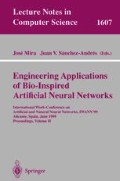Abstract
Color recipe specification in textile print shop requires a great deal of human experience. There is an intrinsic knowledge that makes the computing modeling a difficult task. One of the main issues is the human color perception. A small variation on the intenseness of colorants can lead to very different results. In this paper, we propose to use a Radial Basis Function Networks (RBFN) to color recipe specification in the textile print shop. The method has been applied on a real environment with the following results: it allowed the modeling of the intuitive nature of color perception; it made possible to simulate the color mixing process on a computer; and it became a suitable means for training on color recipe specification.
Preview
Unable to display preview. Download preview PDF.
References
Araújo, M., and Castro, E. M. M.; Manual de Engenharia Têxtil (Textile Engineering Manual), Fundação Calouste Gulbenkian, Lisboa, September 1984.
J. M. Bishop, M. J. Bushnell, and S. Westland, “Application of Neural Networks to Computer Recipe Prediction”. Color research and application, John Willey & Sons, New York, February 1991, pp. 3–9.
R. Hirschler, L.C.R. Almeida, and K.S. Araújo. “Formulação computadorizada de receitas de cores de tingimento e estamparia têxtil: como obter sucesso na indústria” “(Computerized color recipes in textile print shop: how to obtain success in industry”). Quíica Têxtil, Associação Brasileira de Químicos e Coloristas Têxteis, Barueri-São Paulo, September 1995, pp. 61–67.
Moody, J. & Darken, C.J., Fast learning in Networks of locally-tuned processing units, Neural Computation, vol. 1, 281–294, 1989.
R. Luo, P. Rhodes, J. Xin, and S. Scrivener. “Effective colour communication for industry”. JSDC, Society of Dyers and Colorist, Bradford, December 1992, pp. 516–520.
Haykin, Simon, Neural Networks: A Comprehensive Foundation, Macmillan College Publishing Company, New York, 1994
Ribeiro, E.G., Como iniciar uma estamparia em silk-screem (how to open a textile print shop), CNI, Rio de Janeiro, 1987.
Welstead, S.T., Neural network and fuzzy logic applications in C/C++, John Willey & Sons, New York, 1994.
Farina, M., Psicodinâmica das cores em comunicação, (psycho-dynamics of colors in communication) Editora Edgard Blücher Ltda, São Paulo, 1990.
Vigo, T., Textile Processing and Properties-preparation, dyeing, finishing and performance, Elsevier, Amsterdam, 1994.
Billmeyer, F.W. Jr., and M. Saltzman, Principles of color technology, John Willey & Sons, New York, 1981.
Ingamells, W., Color for textiles, Society of Dyers and Colorist, Bradford, 1993.
M. R. Costa, “Princípios básicos da colorimetria”, (Basic Principles of Coloring) Química Têxtil, Associação Brasileira de Químicos e Coloristas Texteis, Barueri-São Paulo, June 1996, pp. 36–71.
Lammens, J.M.G., A computational model of color perception and color naming, Faculty of the Graduate School of State University of New York at Buffalo, New York, June 1994.
Abe, S., and Lan, M.-S., “A method for fuzzy rule extraction directly from numerical data and its application on pattern classification,” IEEE Trans. on Fuzzy Systems, vol. 3, no. 1, pp. 18–28, 1995.
Hush, Don R. & Horne, B. G., Progress in Supervised Neural Networks: What's New Since Lippmann?, IEEE Signal Processing Magazine, 8–39, January, 1993.
Lee, S. & Kil, R. M., A Gaussian Potential Function Network with hierachically Self-Organizing Learning, Neural Networks, vol. 4, 207–224, 1991.
Wettschereck, D. & Dietterich, T., Improving the Performance of Radial Basis Function Networks by Learning Center Locations, Advances in Neural Information Processing System 4, J. E. Moody, S. J. Hansen and R. L. Lippmann editors, 1133–1140, 1992.
Saha, Avijit & Keeler, J. D., Algorithms for Better Representation and Faster Learning in Radial Basis Function Networks, Advances in Neural Information Processing System 2, D. S. Touretzki editor, 482–489, 1990.
Ishibuchi, H.; Kwon, K.; and Tanaka, H., A learning algorithm of fuzzy neural networks with triangular fuzzy weights, Fuzzy Sets and Systems, vol. 71, pp. 277–293, 1995.
Bonarini, A., Evolutionary Learning of Fuzzy Rules: Competition and Cooperation, in Fuzzy Modeling: Paradigms and Practice, Ed. By W. Pedrycz Kluwer Academic Press, 1996.
TODESCO, José L., Reconhecimento de padrões usando rede neuronal artificial com uma função de base radial: uma aplicação na classificação de cromossomos humanos. Florianópolis, 1995. Tese (Doutorado em Engenharia de Produção)-Engenharia de Produção e Sistemas, UFSC.
TONTINI, Gerson. Automatização da identificação de padrões em gráficos de controle estatistico de processos (CEP) através de redes neurais com lógica difusa. Florianópolis, 1995. Tese (Doutorado em Engenharia Mecânica)—Engenharia Mecânica, UFSC.
Author information
Authors and Affiliations
Editor information
Rights and permissions
Copyright information
© 1999 Springer-Verlag Berlin Heidelberg
About this paper
Cite this paper
Sandro, R., José Leomar, T. (1999). Color recipe specification in the textile print shop using radial basis function networks. In: Mira, J., Sánchez-Andrés, J.V. (eds) Engineering Applications of Bio-Inspired Artificial Neural Networks. IWANN 1999. Lecture Notes in Computer Science, vol 1607. Springer, Berlin, Heidelberg . https://doi.org/10.1007/BFb0100556
Download citation
DOI: https://doi.org/10.1007/BFb0100556
Published:
Publisher Name: Springer, Berlin, Heidelberg
Print ISBN: 978-3-540-66068-2
Online ISBN: 978-3-540-48772-2
eBook Packages: Springer Book Archive

